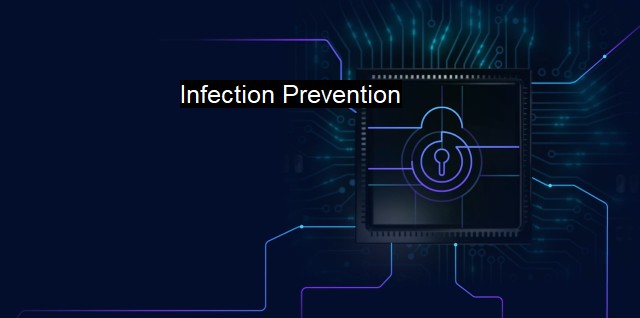What is Infection Prevention?
Preventing Cyber-attacks: The Vital Role of Infection Prevention in Cybersecurity and Antivirus
Infection prevention refers to a series of recommended practices, techniques, and devices designed to avoid, detect, and remove harmful software that may jeopardize a user's security or computer functionality, such as viruses, malware, spyware, adware, ransomware, and so on.When we talk about this subject matter, it is crucial to avert potentially hazardous situations when navigating the online world, performing transactions, and sharing what might be classified as confidential information (for instance, passwords or credit card numbers). Unfortunately, unethical activities such as the creation of risky software have become relatively simplistic, leading to a substantial increment in frequency and sophistication of computer attacks. It's no longer just a question of protecting enormous corporations; small to medium-sized businesses and even individual users are also targeted.
In an ever-increasing digital age, people are significantly relying on technological resources to carry out their daily activities. It is important to have a viable infection prevention mechanism that will impede any malicious software from infecting systems, preserving their integrity. It is a multi-level process that requires an overhaul at the technical level, regular updates, and informational approach where users empower themselves with ways to secure their digital environment.
At the heart of infection prevention stands the antivirus software. These are applications that are specifically developed to detect, stop, and remove software viruses. They come in the form of software that is installed on a computer and are typically updated on a regular basis to spot and inhibit the latest viruses harassing the cyber environment.
The effectiveness of infection prevention is underpinned by the updates of the antivirus software. These updates allow the antivirus software to extend its virus signature database—a database that contains all known virus signatures or identifiers. You might imagine it as the face or the fingerprint of a virus; every virus has its unique signature. When a computer is scanned by an antivirus, it is essentially going through the computer's data and comparing any found malware with what exists in its database. The infection is efficiently halted and taken care of if a match is detected.
Further to using antivirus software, infection prevention extends to techniques like safe email habits, internet navigation caution, secure use of storage media, and updating patches in the operating system as soon as they're released. Employing strong, unique passwords, and using multi-factor authentication can drastically reduce the chances of an infiltration. One must also be wary of unsolicited emails that aim to trigger a user's curiosity; these malware-laden emails, commonly known as phishing, are masked as socially engineered schemes trying to solicit sensitive information out of an unsuspecting user and gaining conditional access.
Apart from these protective measures, a good back-up policy and disaster management plan are crucial to prepare for worst-case scenarios where networks are penetrated despite precautions, to avoid loss of valuable digital assets.
Constant education and training on infection prevention is also compulsory; it focuses on maintaining a discipline of digital cleanliness and sanitary computing habits. Computer systems need to be kept clean, just like we keep our physical surroundings clean and germ-free.
Infection prevention is as dynamic as the digital world; the landscape is forever changing, with intrusions becoming ever shrewd at bypassing security measures and remaining hidden. In such an age, the line of defense is built not only around robust hardware or software measures but includes the individual proficiency of the end-users. A simple act, like clicking a link, can be catastrophic. Knowledge, therefore, coupled with proactive and reactive measures, ensures that the only infections are the ones that fail in their malevolent intentions.

Infection Prevention FAQs
What is infection prevention in cybersecurity?
Infection prevention in cybersecurity refers to the set of measures and practices implemented to protect computer systems and networks from malicious software such as viruses, malware, and ransomware. These measures include installing antivirus software, implementing security patches, and conducting regular security audits.Why is infection prevention important in cybersecurity?
Infection prevention is crucial in cybersecurity because cyberattacks can cause significant damage to computer systems, such as stealing sensitive data, taking control of computers, and spreading malware across the network. Implementing infection prevention measures helps to ensure that computer systems and networks are protected from these types of attacks.What are some infection prevention best practices for cybersecurity?
Some best practices for infection prevention in cybersecurity include ensuring that antivirus software is installed and up to date, regularly backing up important data, implementing strong passwords and multi-factor authentication, and educating users about safe online behavior such as avoiding suspicious emails and websites.How can I assess the effectiveness of infection prevention measures in cybersecurity?
To assess the effectiveness of infection prevention measures in cybersecurity, you can conduct regular security audits, monitor system logs and network traffic, and perform vulnerability scans. It is also important to stay up to date with the latest cybersecurity threats and trends and adjust infection prevention measures accordingly.| | A | | | B | | | C | | | D | | | E | | | F | | | G | | | H | | | I | | | J | | | K | | | L | | | M | |
| | N | | | O | | | P | | | Q | | | R | | | S | | | T | | | U | | | V | | | W | | | X | | | Y | | | Z | |
| | 1 | | | 2 | | | 3 | | | 4 | | | 7 | | | 8 | | |||||||